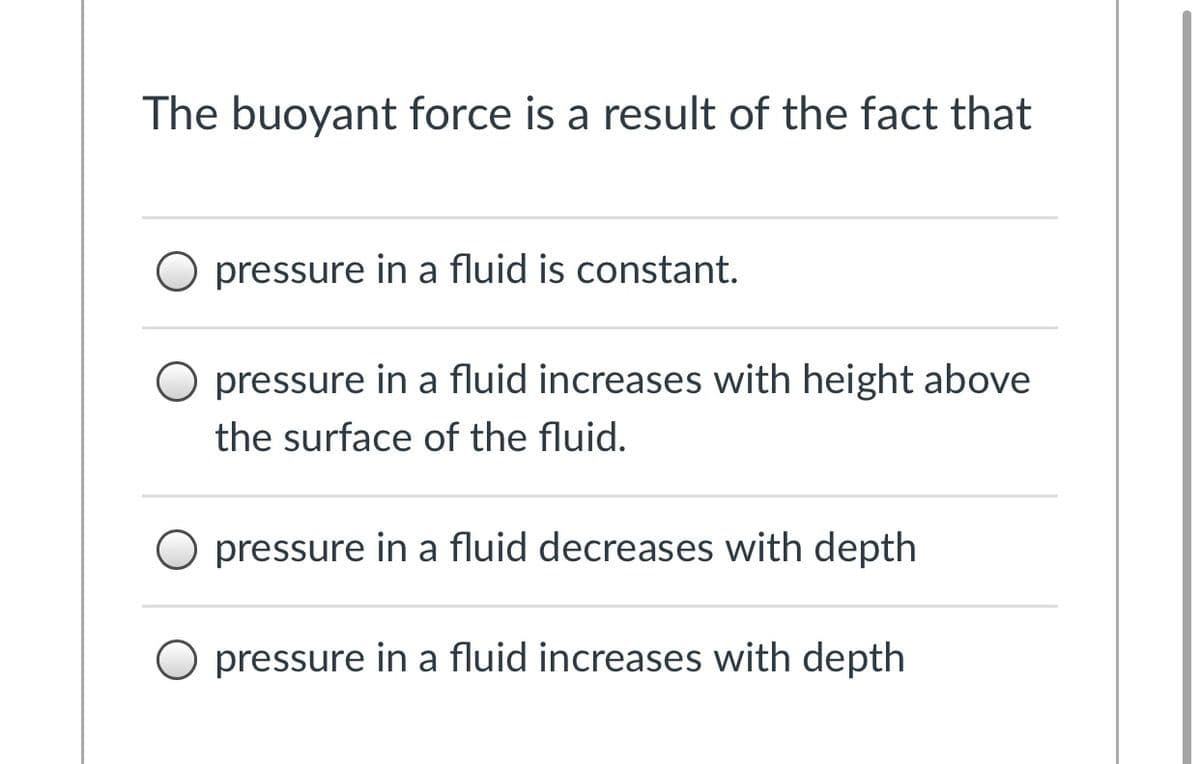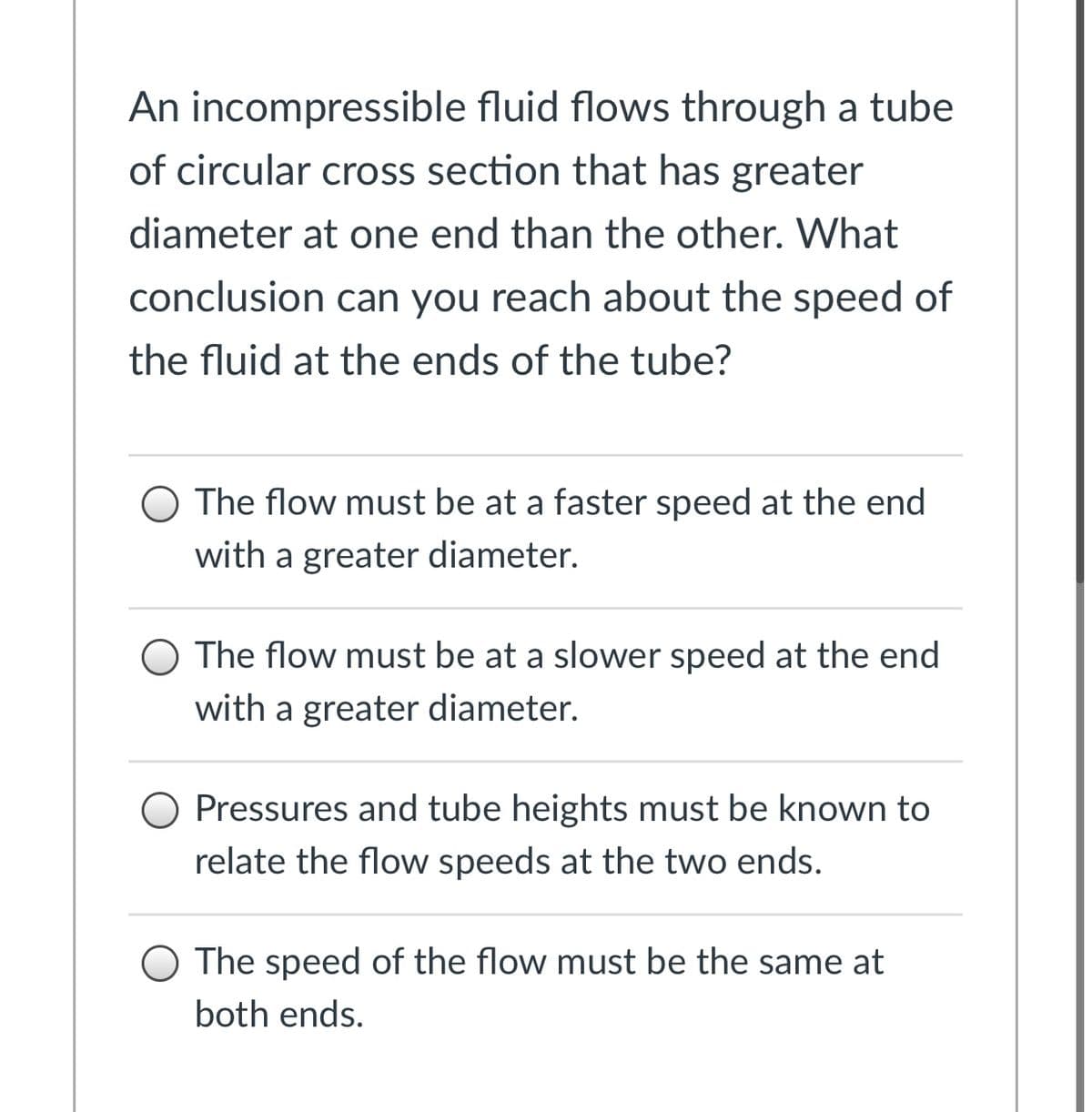The buoyant force is a result of the fact that O pressure in a fluid is constant. O pressure in a fluid increases with height above the surface of the fluid. O pressure in a fluid decreases with depth O pressure in a fluid increases with depth
The buoyant force is a result of the fact that O pressure in a fluid is constant. O pressure in a fluid increases with height above the surface of the fluid. O pressure in a fluid decreases with depth O pressure in a fluid increases with depth
University Physics Volume 1
18th Edition
ISBN:9781938168277
Author:William Moebs, Samuel J. Ling, Jeff Sanny
Publisher:William Moebs, Samuel J. Ling, Jeff Sanny
Chapter14: Fluid Mechanics
Section: Chapter Questions
Problem 102P: A fire hose has an inside diameter of 6.40 cm. Suppose such a hose caries a flow of 40.0 L/s...
Related questions
Question

Transcribed Image Text:The buoyant force is a result of the fact that
pressure in a fluid is constant.
O pressure in a fluid increases with height above
the surface of the fluid.
pressure in a fluid decreases with depth
O pressure in a fluid increases with depth

Transcribed Image Text:An incompressible fluid flows through a tube
of circular cross section that has greater
diameter at one end than the other. What
conclusion can you reach about the speed of
the fluid at the ends of the tube?
The flow must be at a faster speed at the end
with a greater diameter.
O The flow must be at a slower speed at the end
with a greater diameter.
Pressures and tube heights must be known to
relate the flow speeds at the two ends.
O The speed of the flow must be the same at
both ends.
Expert Solution
This question has been solved!
Explore an expertly crafted, step-by-step solution for a thorough understanding of key concepts.
This is a popular solution!
Trending now
This is a popular solution!
Step by step
Solved in 2 steps

Knowledge Booster
Learn more about
Need a deep-dive on the concept behind this application? Look no further. Learn more about this topic, physics and related others by exploring similar questions and additional content below.Recommended textbooks for you

University Physics Volume 1
Physics
ISBN:
9781938168277
Author:
William Moebs, Samuel J. Ling, Jeff Sanny
Publisher:
OpenStax - Rice University

Principles of Physics: A Calculus-Based Text
Physics
ISBN:
9781133104261
Author:
Raymond A. Serway, John W. Jewett
Publisher:
Cengage Learning

College Physics
Physics
ISBN:
9781938168000
Author:
Paul Peter Urone, Roger Hinrichs
Publisher:
OpenStax College

University Physics Volume 1
Physics
ISBN:
9781938168277
Author:
William Moebs, Samuel J. Ling, Jeff Sanny
Publisher:
OpenStax - Rice University

Principles of Physics: A Calculus-Based Text
Physics
ISBN:
9781133104261
Author:
Raymond A. Serway, John W. Jewett
Publisher:
Cengage Learning

College Physics
Physics
ISBN:
9781938168000
Author:
Paul Peter Urone, Roger Hinrichs
Publisher:
OpenStax College

Physics for Scientists and Engineers: Foundations…
Physics
ISBN:
9781133939146
Author:
Katz, Debora M.
Publisher:
Cengage Learning

Glencoe Physics: Principles and Problems, Student…
Physics
ISBN:
9780078807213
Author:
Paul W. Zitzewitz
Publisher:
Glencoe/McGraw-Hill

An Introduction to Physical Science
Physics
ISBN:
9781305079137
Author:
James Shipman, Jerry D. Wilson, Charles A. Higgins, Omar Torres
Publisher:
Cengage Learning